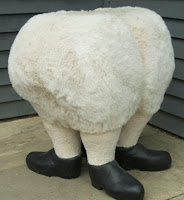 |
| Edward Hopper - Morning in a City 1944 |
 |
| Unknown artist, Gabon 20th century Mbulu-Ngulu (reliquary figure) |
Rather, the method is to present a remarkably wide range of objects in challenging (but not needlessly provocative) juxtapositions, and then to offer questions about the objects, their context, their provenance, and their ultimate placement in these two prominent university collections. The result is a virtual tour of human civilization, guided but open-ended, which features curious side trips that focus on how we experience objects and art. The natural questions that we would ask on such a trip are posted for us, and some potential answers are, too, but it never feels that we are being pandered or preached to.
 |
| Unknown artist (Roman) late 3rd century Sarcophagus fragment of Hercules, Triumph of Dionysos |
Then again, a friend who accompanied me on this visit, and who is a lifelong art lover now past 70 years old, proclaimed about halfway through our tour that Reflections on a Museum is probably the best museum exhibition he has ever seen. So there's a ringing endorsement if I ever heard one.
Two years in the making, the exhibitions began opening in staggered fashion in April and will remain on view through next June. The scale of the project, and the museum's free admission policy, will surely encourage multiple visits, as will The Gallery of Crossed Destinies, where 25 objects are being installed differently by four different guest curators in sequence through 2011; and the Room for Reflection, where a single work of art is showcased each month (through December).
 |
Robert Wilson Bridge Chair with Shadow 1999 |
The museum's first-floor galleries introduce the concept of the exhibitions with a show titled The Object of Art. Here, essential questions are posed: How does art start? What is it? What is it doing here? and so on. The two galleries contain a great variety of objects, from the plainly utilitarian to the utterly conceptual, and we are encouraged to consider them in relation to each other and in relation to our own thoughts, freely formed or inculcated, about what their object may be.
In one fine pairing, a work of art that is a door (by Jim Dine) sits next to a door that is a work of art (anonymously carved granary door from 19th- or 20th-century Mali). The wall text reads "Q. When is a door not a door? A. When it's a work of art." The beauty of this presentation is that it leaves it up to the viewer to consider how this Q&A may apply to the particular doors on the wall, and to recognize that intention and context both determine the meaning of an object and are mutable. Not incongruously, a complex collector's item that consists of a miniature museum-in-a-box of Marcel Duchamp reproductions sits nearby.
 |
| Wybrand Simonsz de Geest the elder Portrait of a Man 1630 |
 |
| Zwelethu Mthethwa - Untitled 2006 |
Stromberg, working his last day at the WCMA before departing for Mount Holyoke, made a compelling case for his favorite color, and for its use in the works cited. He also makes, in a short and humbly placed "Curator's Voice" text panel in a gallery dedicated to Cosmopolitan Modernism, a compelling case for the entire Reflections on a Museum exhibition and the spirit behind it. He writes, "I feel that objects have a kind of 'bill of rights': They deserve to be cared for, displayed to best advantage, and interpreted in ever-changing combinations that keep them alive conceptually."
Reflections on a Museum lives up to that credo.
Additional sections of the installation are: Don't Fence U.S. In: Crossing Boundaries in American Art; Art Re: Art; A Collection of Histories; and an Artist's Project by artist-in-residence Jesse Aron Green.
Rating: Must See
 |
| Grant Wood - Death on Ridge Road 1935 |









